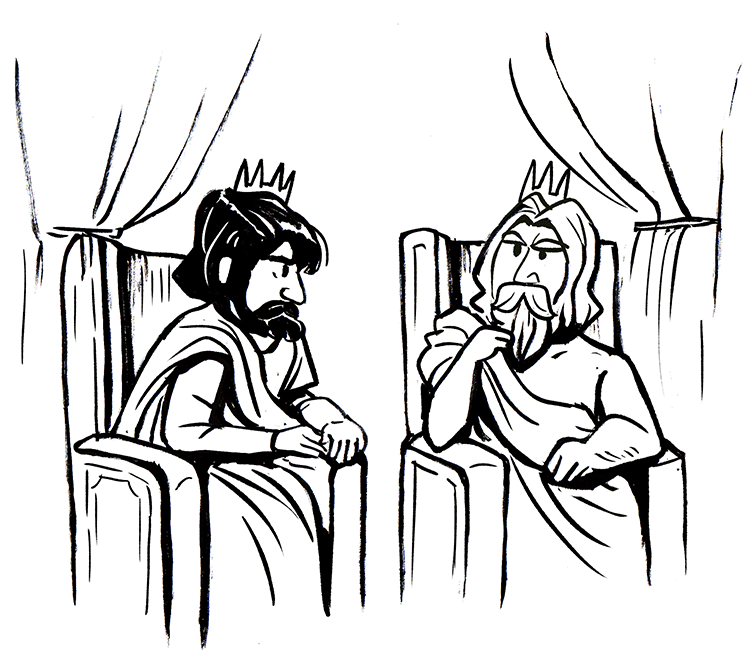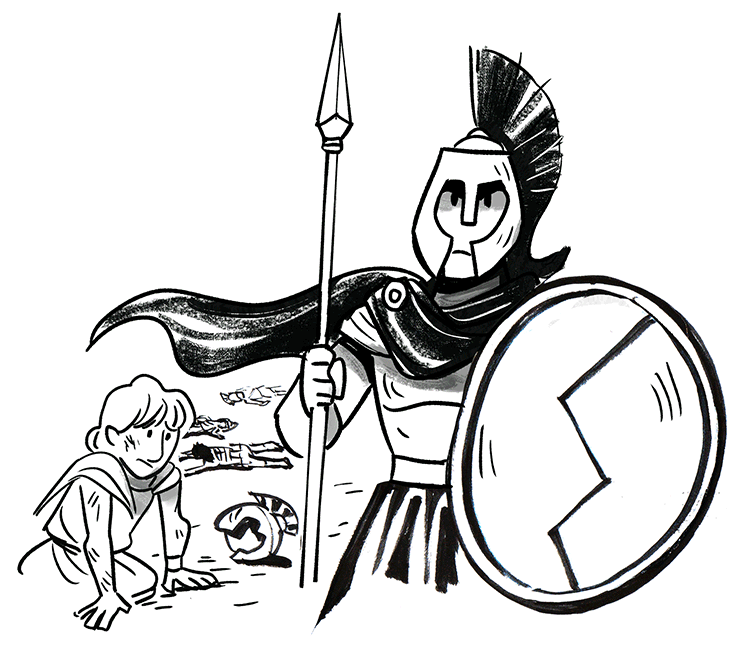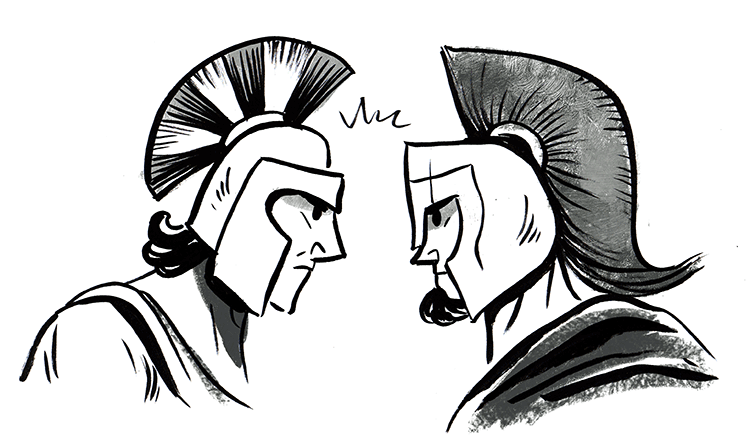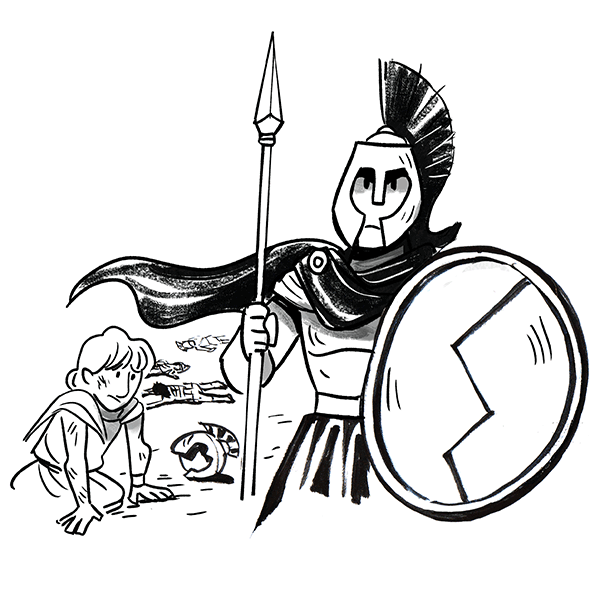“Spartans! What is your profession!”
“Aaaaa-oooo! Aaaaa-oooo!”
This cry, made famous from the 2006 action film 300, paints a picture of Sparta, the most famous Greek city-state alongside Athens, as a violent, militaristic culture that put warfare above all else.
Such a depiction, while designed for Hollywood, isn’t too far off the mark. Sparta was a highly-militaristic city-state whose warriors were feared by all cultures of the ancient world. But they didn’t use this culture for aggression.
Instead, they were much more concerned with protecting their own territory. And, whenever possible, they tried to stay out of the ever-changing world of Greek politics. Except when their archenemy, Athens, left them no choice…

Sparta: A City?
If we look at a modern map of Sparta, it looks like any old city. But if we rewind a few thousand years to the founding of Sparta, it was anything but.
In fact, the Sparta that rose to fame in the ancient world was really a collection of five different towns. Well, at first it was just four. The town of Limnai absorbed the town of Kyosoura, and then the town of Pitana scooped up Mesoa. Later, Amyclae joined the party, and Sparta as we know it was born.
While this wasn’t an unheard of practice in ancient times, things were different in Sparta because it led to the formation of a government that had two kings. The ruling families from Pitana and Kyosusoura couldn’t agree on who should be the one in charge, so they decided to rule together.
This arrangement held up for most of Sparta’s history, making it a true oddball in Ancient Greece.
The Fertile Eurotas Valley
Sparta is located on the Peloponnese, the largest peninsula on mainland Greece. It’s also located on the banks of the Eurotas River, giving it access to some of the best farmland in a place where good, arable soil was pretty hard to find.
In addition to being close to a river and fertile land, the Eurotas Valley is also protected by two towering mountains – Mt. Taygetos and Mt. Parnon – which provided a natural boundary wall from outside invaders.
All of this meant that Mother Nature left Sparta in a pretty good position. The fertile farmland allowed civilization to flourish, and the tall mountains kept everyone else out.
No wonder they turned into the biggest introverts of the Greek world!
The Dorian “Invasion”
The Spartans were Dorians, meaning they spoke a dialect of Greek known as Doric. The other major dialects/groups include Ionic, Achaean, and Aeolic.
Although these were just dialects and speakers of each could understand one another, city-states often aligned based on which version of Greek they were speaking.
Over time, the Dorians became the dominant group on the Peloponnese. But it wasn’t always this way.
In fact, the Dorians likely came from much further north and didn’t appear on the peninsula until around 1000 BC, shortly after the Mycenaens – the first Greeks – left town.
According to Spartan history, this was the result of a purposeful “invasion” by the Dorians. But historians debate this. Instead, it’s far more likely that the Dorians were forced to flee their homeland as their population grew and they started running out of farmland.
This took place at around the same time the Mycenaean civilization was collapsing, opening the door nicely for the Dorians to move in.
However, it’s much more likely that the Spartans invented this whole invasion story to establish a common history that would bring the people together and make them easier to rule.
Though the invasion thing sounds nice, doesn’t it?
The Messenian Wars
Sparta is located in a fertile region known as Laconia, the largest in the Peloponnese. Directly to the west is Messenia, another rather fertile region.
As the Dorians made their way into the region, instead of making friends, they put on their conqueror hats and started earning their reputation as fierce warriors.
The first conflict, known as The First Messenian War (because the Spartans won and got to choose the name) took place around 740 BC. After their victory, the Spartans kicked out large portions of the population, and those they allowed to stay…they turned into slaves!
Throughout much of Sparta’s history, they were fighting with their neighbors. Not wanting to be slaves, the Messennians frequently rebelled, and so the Spartans were always having to put these insurrections down. But the reason this was so important was because of the way in which Spartan society was constructed.

Spartan Society: Citizens and Slaves
Spartan society was very unequal.
At the top were Spartan citizens, a title that only those who could trace their ancestry to the original settlers of Sparta could claim. Some exceptionally good soldiers were later made Spartans, but this was not the norm.
Spartan boys were put into military school at an early age and trained to be soldiers. No little league and sleepovers for them!
In these schools, they were organized into small groups so that they could build deep connections and trust with their fellow fighters. This is what helped make the Spartan army so strong and powerful.
Women were also sent to school, something that was not normal in the rest of Greece at the time. Though they were not expected to be soldiers. Instead, they were supposed to stay in shape so that they could have strong, Spartan children.
Citizens had all the power, and they were actually forbidden from doing manual labor. In other words, they were born with privilege, and when they weren’t off fighting wars, they were hanging out living the good life.
But someone had to do the work. Enter the slaves.
Spartan slaves were known as helots. Those who lost to Sparta in war – mainly the Messenians – took on this role.
They weren’t allowed to own land and they had no political power. They couldn’t even move from one place to another, and they were also required to go off and fight Spartan wars. And as if this weren’t bad enough, they were also beaten each year to be reminded of their place. No one ever said the Spartans were nice.
Given how terrible this life must have been, the helots were always looking for a chance to rebel. As a result, the Spartans spent a lot of their time putting down these rebellions.
There was a third class of people in Sparta, known as the perioikoi, that made up a very small percentage of the population.
They were allowed to own property and had some rights, though they could never become citizens. Often, they were asked to join the Spartan army in war, and if they performed well, they could earn certain privileges and rights.
War with Persia and Athens
For most of their history, the Spartans liked to keep to themselves. They liked their little slave society and their fertile farmland, and they didn’t really care too much about what was going on in the rest of Greece.
Then the Persians messed all that up.
The Persians invaded Greece twice, and they were far more powerful than any one Greek city-state. Athens, which was often the de facto leader of Greece, called upon Sparta to help defend against these foreign invaders.
At first, Sparta was like “nah!” But after it became clear that the Persians meant business, they decided to join up in the fight to keep Greece safe. They played a key role in winning the Battle of Marathon as well as the Battle of Plataea, the two conflicts that kept the Persians away.
They also fought valiantly in the famous Battle of Thermopylae, though they were defeated. Yet their famous last stand has gone down as a legend, even making it into modern Hollywood. This battle was the premise of the film 300.
After chasing away the Persians, Athens started getting pretty full of itself and made alliances with other Greek city-states that eventually became a small empire. Sparta, along with its allies, a group known as the Peloponnesian League, pushed back and the two cities fought the Peloponnesian War.
This war lasted more than 30 years, but the Spartans finally won, in part because Athens got a bit too greedy and really blew it. But no matter the reason, this victory opened the door for Sparta to be the leader of the Greek world, even for just a brief moment.

The Fall of Sparta
Shortly after beating Athens, Sparta began to decline. Their strict citizenship requirements made it so that they had a population problem. In other words, Sparta was running out of Spartans!
The helots saw this as an major opportunity and rebelled big time, and then Sparta was defeated by Thebes in the Boeotian Wars.
This pretty much reduced Sparta to its weakest position in history, and so when the Romans arrived, well, no more Sparta. The city remained throughout Roman times, but unlike its rival Athens which has remained relevant until the modern day, it never reached the same position again.
Even today it is just a small city of no more than 16,000 people. Athens is the capital of Greece with a population of more than half a million.
Despite this “sudden” fall, Sparta was one of the most powerful cities of ancient Greece. Without its army, Greece may very well have disappeared at the hands of the Persians, and who knows what impact that would have had on history.
However, in the end, stark inequalities and an excessively militaristic and harsh culture brought one of the ancient world’s most powerful city-states crumbling to its knees
Written by Matthew Jones
Illustrated by Meimo Siwapon
